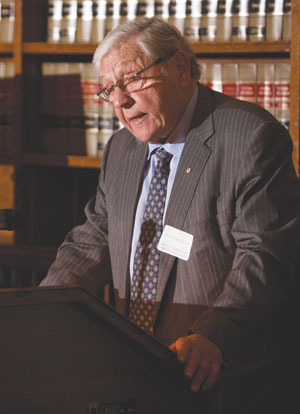A new map of Ontario’s civil legal services has produced the first solid data comparing lawyer and paralegal distribution to the barriers faced by low- and middle-income communities across the province, says former chief justice Roy McMurtry.

McMurtry, chairman of the steering committee for the Ontario Civil Legal Needs project, made the announcement during the release of its third and final report at the Law Society of Upper Canada last week.
“While the public release of this report complements the third and final phase of the project, it is, in many ways, not an end, but a new beginning,” says McMurtry.
“Now that we can identify where demand exists for civil legal services with the previous report, and we know where Ontario lawyers and paralegals are practising and in what areas of law they are practising with this final report, we can ask ourselves, what’s next?”
Gathered heavily from 2006 Statistics Canada census data and the law society’s database of licensed lawyers and paralegals in Ontario, the report found the distribution of practitioners across the province to be relatively in line with the population distribution of low- and middle-income communities.
However, the type of services provided by those lawyers and paralegals produced several surprises.
“The characteristics of the distribution of lawyers and paralegals are, we believe, an accurate measure of supply, since it is reasonable to assume that these service providers choose where to practise based in large part on where professional opportunities exist,” the report states.
In terms of pro bono services, “the result is overwhelmingly positive and surprising,” it noted.
According to the report, nearly half of Ontario lawyers reported that they provided pro bono legal services in 2009, with much of that activity happening in areas like Haliburton and Rainy River, Ont.
In Toronto, 42 per cent of lawyers reported that they had provided pro bono services during that time.
“Half of all Ontario lawyers do pro bono work,” said Lorne Sossin, dean of Osgoode Hall Law School.
“That can be seen as either good or bad depending on whether or not you’re the glass-half-full or glass-half-empty type, but we like to think of it as a positive sign and we hope this report builds on this evidence and action in the future.”
Another issue addressed in the report was the number of lawyers and paralegals working in rural communities. While the numbers are generally in line with population data, it called for action to further reflect the needs of the communities.
According to the report, large geographical areas in places like northwestern Ontario had as few as 38 lawyers, while major metropolitan regions like Toronto had as many as 11,000 of them in 2009.
Still, law society Treasurer Laurie Pawlitza said the report is encouraging despite those challenges. “The report confirms something we long suspected,” said Pawlitza.
“It’s clear to us that there needs to be greater support in these areas, particularly for what we call soles and smalls. The LSUC thinks tremendous progress has been made so far and will continue to work toward targeting increases in access to justice.”

 McMurtry, chairman of the steering committee for the Ontario Civil Legal Needs project, made the announcement during the release of its third and final report at the Law Society of Upper Canada last week.
McMurtry, chairman of the steering committee for the Ontario Civil Legal Needs project, made the announcement during the release of its third and final report at the Law Society of Upper Canada last week.